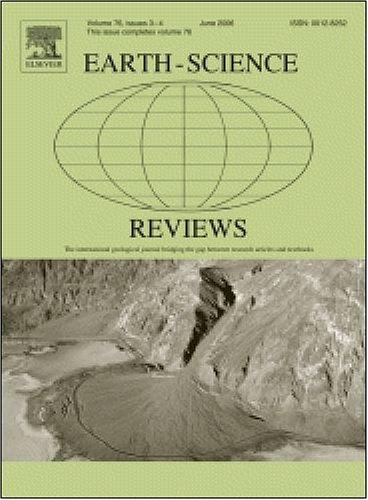The Hf and O isotope record of long-lasting accretionary orogens: The example of the Proterozoic and Paleozoic-Triassic central South America
IF 10.8
1区 地球科学
Q1 GEOSCIENCES, MULTIDISCIPLINARY
引用次数: 0
Abstract
The southwestern margin of Amazonia hosted accretionary orogens for most of the past 2 Ga. A succession of accretionary mountain belts evolved from 2 Ga to 1 Ga, they are here informally grouped in the Terra Amazonica Orogen. It occupies large tracts of the Amazonian Shield, is poorly exposed and often inaccessible. Its evolution ended when Amazonia collided with Laurentia at 1 Ga in Rodinia. After the dispersal of Rodinia, an accretionary margin was re-established by 0.65 Ga, starting the proto-Andean accretionary Terra Australis Orogen.
Large volumes of polycyclic detritus derived ultimately from the Terra Amazonica Orogen was trapped in the sedimentary basins of the Terra Australis Orogen. Using this detritus we assess the crustal evolution of both orogens with new zircon U-Pb age (n = 12,752), Hf isotope (n = 5502) and O isotope (igneous n = 855, detrital n = 957) databases for zircons including our own new analyses and literature data.
For the Terra Amazonica Orogen three subcycles of zircon εHf(t) values define a cumulative trend from strongly unradiogenic to radiogenic values. In accretionary orogens, such trends indicate the progressive removal of lower crust and lithospheric mantle of the upper plate during subduction and their replacement by new radiogenic crust.
Early Neoproterozoic rifting of Rodinia registered a drop in mean εHf(t) values by eleven units from +4 to −7. This is superseded by a two-step increase to values between 0 and + 5 after the inception of the active margin of the Terra Australis Orogen, registering one large cycle with two subcycles from negative to positive values typical of accretionary orogens.
Zircon δ18O data show a flat mean trend at slightly elevated values of 6.3 ‰ over the first 800 Myr of the Terra Amazonica Orogen, increasing to ca. 7.3 ‰ towards collision with Laurentia. Encompassing the Terra Amazonica Orogen and Neoproterozoic rifting, mean δ18O from detrital zircons is consistently lower than the igneous mean, indicating a wider distribution of mantle-like rocks than previously considered. δ18O of the Terra Australis Orogen trends from supracrustal 8 ‰ to more mantle-like values around 6.5 ‰, paralleling the accretionary orogen trend from unradiogenic to radiogenic εHf(t) values.
Global zircon δ18O data suggest a gradual increase of δ18O after 2.5 Ga connected to the progressive hydration and intra-crustal reworking of the continental crust. Our data register the sudden appearance of elevated δ18O values up to 10 ‰ at 2.5 Ga. Amazonia has been an independently drifting entity with an active margin at least from the late Archean to the collision with Laurentia. δ18O values up to 10 ‰ at 2.5 Ga may have appeared because the upper crust of Amazonia had already experienced alteration and crustal recycling at an accretionary margin since long before 2.5 Ga.
The Amazonian and proto-Andean detrital zircon age record is statistically similar to the global record. We argue that large scale continent-wide sedimentary reworking of detritus results in efficient mixing of the detrital zircon age records of accretionary and collisional orogens. We conclude that the global detrital zircon age record represents the averaged record of the successive supercontinent cycles.

长期增生造山带的Hf和O同位素记录:以南美洲中部元古代和古生代-三叠纪为例
亚马逊河西南边缘在过去2亿年的大部分时间里都是增生造山带。从2 Ga到1 Ga,一系列的增生山带演化而成,它们在这里被非正式地归类于Terra Amazonica造山带。它占据了亚马逊地盾的大片土地,暴露程度很低,经常无法进入。它的进化结束于亚马逊与劳伦西亚在1ga前在罗迪尼亚相撞。罗迪尼亚分散后,在0.65 Ga重新建立了一个增生边缘,开始了原安第斯增生的南陆造山带。大量最终来自亚马逊河造山带的多旋回碎屑被困在南地造山带的沉积盆地中。利用这些碎屑,我们利用新的锆石U-Pb年龄(n = 12,752)、Hf同位素(n = 5502)和O同位素(n = 855,碎屑n = 957)数据库(包括我们自己的新分析和文献数据)评估了两个造山带的地壳演化。对于Terra Amazonica造山带,锆石εHf(t)值的三个亚旋回定义了从强非放射成因值到放射成因值的累积趋势。在增生造山带中,这种趋势表明在俯冲过程中下地壳和上板块岩石圈地幔的逐渐移除,并被新的放射成因地壳所取代。罗迪尼亚早新元古代裂陷作用的平均εHf(t)值从+4降至- 7,下降了11个单位。在南陆造山带活动边缘开始后,这一过程被两个步骤的增加所取代,在0到+ 5之间,记录了一个大旋回和两个从负值到正值的亚旋回,这是典型的增生造山带。锆石δ18O值在前800 Myr呈平缓的平均上升趋势,略高于6.3‰,与Laurentia碰撞后上升至7.3‰左右。碎屑锆石的平均δ18O一直低于火成岩的平均值,这表明地幔状岩石的分布比以前认为的要广泛。南陆造山带的δ18O值从8‰向6.5‰左右更接近地幔样,与非放射性造山带的δ hf (t)值向放射性造山带的δ hf (t)值趋同。全球锆石δ18O数据表明,2.5 Ga后δ18O逐渐增加,与大陆地壳的逐渐水化和地壳内部改造有关。我们的资料显示,在2.5 Ga时δ18O值突然升高,最高达10‰。至少从太古宙晚期到与劳伦西亚的碰撞,亚马逊一直是一个独立的漂流实体,有一个活跃的边缘。由于早在2.5 Ga以前,亚马逊河流域上地壳就已经经历了蚀变和地壳再循环,在2.5 Ga时可能出现了高达10‰的δ18O值。亚马逊河和原安第斯碎屑锆石年龄记录在统计上与全球记录相似。我们认为,大规模的全大陆范围的碎屑沉积改造导致了增生造山带和碰撞造山带碎屑锆石年龄记录的有效混合。我们认为全球碎屑锆石年龄记录代表了连续超大陆旋回的平均记录。
本文章由计算机程序翻译,如有差异,请以英文原文为准。
求助全文
约1分钟内获得全文
求助全文
来源期刊

Earth-Science Reviews
地学-地球科学综合
CiteScore
21.70
自引率
5.80%
发文量
294
审稿时长
15.1 weeks
期刊介绍:
Covering a much wider field than the usual specialist journals, Earth Science Reviews publishes review articles dealing with all aspects of Earth Sciences, and is an important vehicle for allowing readers to see their particular interest related to the Earth Sciences as a whole.
 求助内容:
求助内容: 应助结果提醒方式:
应助结果提醒方式:


